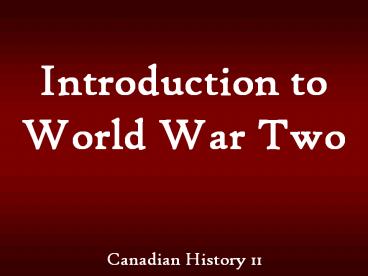Introduction to World War Two - PowerPoint PPT Presentation
1 / 18
Title: Introduction to World War Two
1
Introduction to World War Two
- Canadian History 11
2
Underlying Causes of World War Two
- Treaty of Versailles
- The Great Depression
- The Failure of the League of Nations
(Appeasement) - The Rise of Militarism
3
Treaty of Versailles
- The Treaty of Versailles signed in 1919. It was
a humiliating Treaty for Germany because of the
following reasons - a) It stated that Germany had to pay back
millions of dollars - in reparations
- b) It stated that the German army could be no
greater than - 100000 men
- c) It stated that the German navy could not
build any large war - ships
- d) It stated that there could be no German air
force - e) It stated that the German empire was to be
divided among the - victorious allies
- The idea behind the treaty was that Germany would
never be strong enough to declare war on any
other country in Europe. Germany was forced to
sign the treaty. Adolf Hitler used the treaty to
stir up German nationalism. This helped him gain
political power in the 1930s.
4
The Great Depression
- In October 1929, the global stock market
crashed. This began the Great Depression, - Millions of people all over the world, especially
in North America and Europe, were out of work and
had no hopes of finding work. - People were going hungry all over the world until
the mid 30s. A vicious cycle had been created. - No workno money to buy foodno one buying food
or productsno work
5
Failure of the League of Nations (Appeasement)
- The League of Nations was the brainchild of
Woodrow Wilson, President of the United States
during World War I. - The League consisted of nations, including
Canada, that would ban together so wars such as
WW I would not occur again. One principle of the
League was collective security (if one member of
the League was attacked by another power, other
members of the League would send military support
to the country being attacked). - A major weakness of the League of Nations was
that the United States was not a member.
6
Rise of Militarism
- Three key events lead to the Rise of Militarism
before WWII. - a) In 1904-05, Japan defeated Russia in the
Russo-Japanese War. Next, Japan began a war with
China. - b) Mussolini defied the League of Nations by
invading Ethiopia in 1935. - c) Hitler also defied the League of
Nations. In 1935 Hitler enlarged the German Army
from 100 000 men to 350 000 men. Germany
embarked on an intensive naval program. They
also began to build up the German Air force. All
of these actions went against the Treaty of
Versailles.
7
The Other ISMs
8
Nationalism
- Another underlying factor causing the war,
Nationalism was the primary reason for German,
Italian and Japanese aggression. - Fascism in these countries was built largely upon
nationalism and the search for a cohesive nation
state
9
Nazism
- What is Nazism?
- Extremely fascist , nationalistic and
totalitarian - Based on beliefs of the National Socialist German
Workers Party - Belief in the racial superiority of the Aryan,
the master race - Belief that all Germans should have lebensraum
or living space in Europe - Violent hatred towards Jews and blamed Germanys
problems on them
10
Communism?
- What is Communism?
- LEFT WING
- Based on a theory by Karl Marx
- Revolutionary idea of a political, economic
and social system that creates a classless
society - State ownership and control of the means of
production (no private ownership) - Soviet Communism or Stalinism, was more of a
totalitarian and military state combined with
elements of communism
11
Fascism
- What is Fascism?
- RIGHT WING
- Intense nationalism and elitism
- Totalitarian control
- Interests of the state more important than
individual rights - Maintain class system and private ownership
12
Totalitarianism
- Government establishes complete control of all
aspects of the state(political, military,
economy, social, cultural) - Highly nationalistic (flags, salutes, rallies,
uniforms) - Strict controls and laws
- Military state (secret police, army, military)
- Censorship (opposing literature and ideas)
- Propaganda (media radio, newspapers, posters)
- One leader (dictator) charismatic
- Total conformity of people to ideas and leader
- Terror and Fear
13
Nazism
Totalitarianism
Communism
Fascism
These theories, specifically Communism and
Fascism, are completely different theories that
are bitterly opposed however they exhibit the
same behaviour
14
Territory
- Many of the members of the Triple Alliance and
their allies had lost a significant amount of
territory in the First World War. - This attitude led many members of these nations
to support those individuals and political
parties who wished to gain territory for these
nations
15
(No Transcript)
16
(No Transcript)
17
In the Beginning
- The Second World War officially began with the
German Invasion of Poland on September 1st 1939.
- Canada as a member of the commonwealth declared
war on September 10th 1939.
18
(No Transcript)































